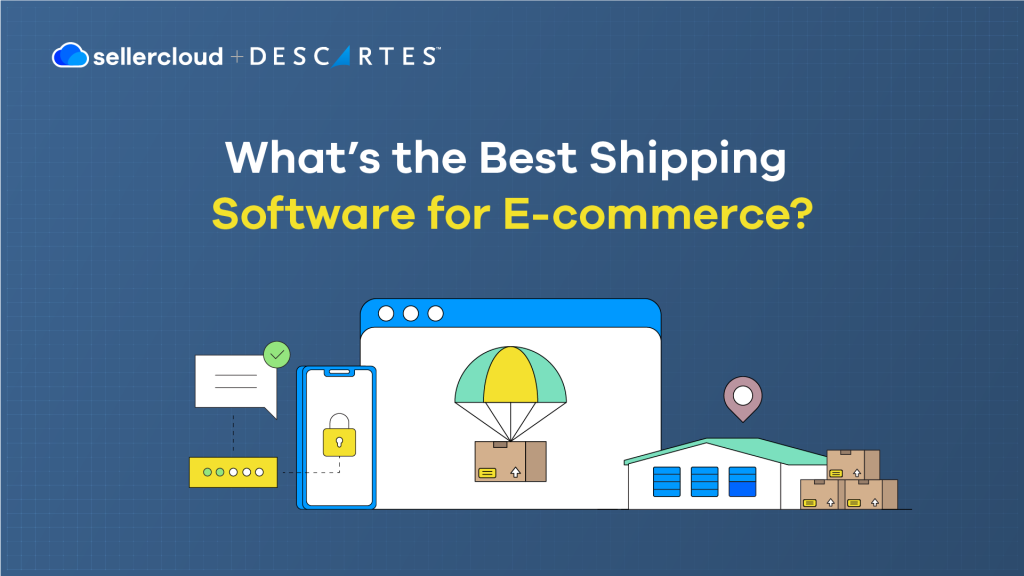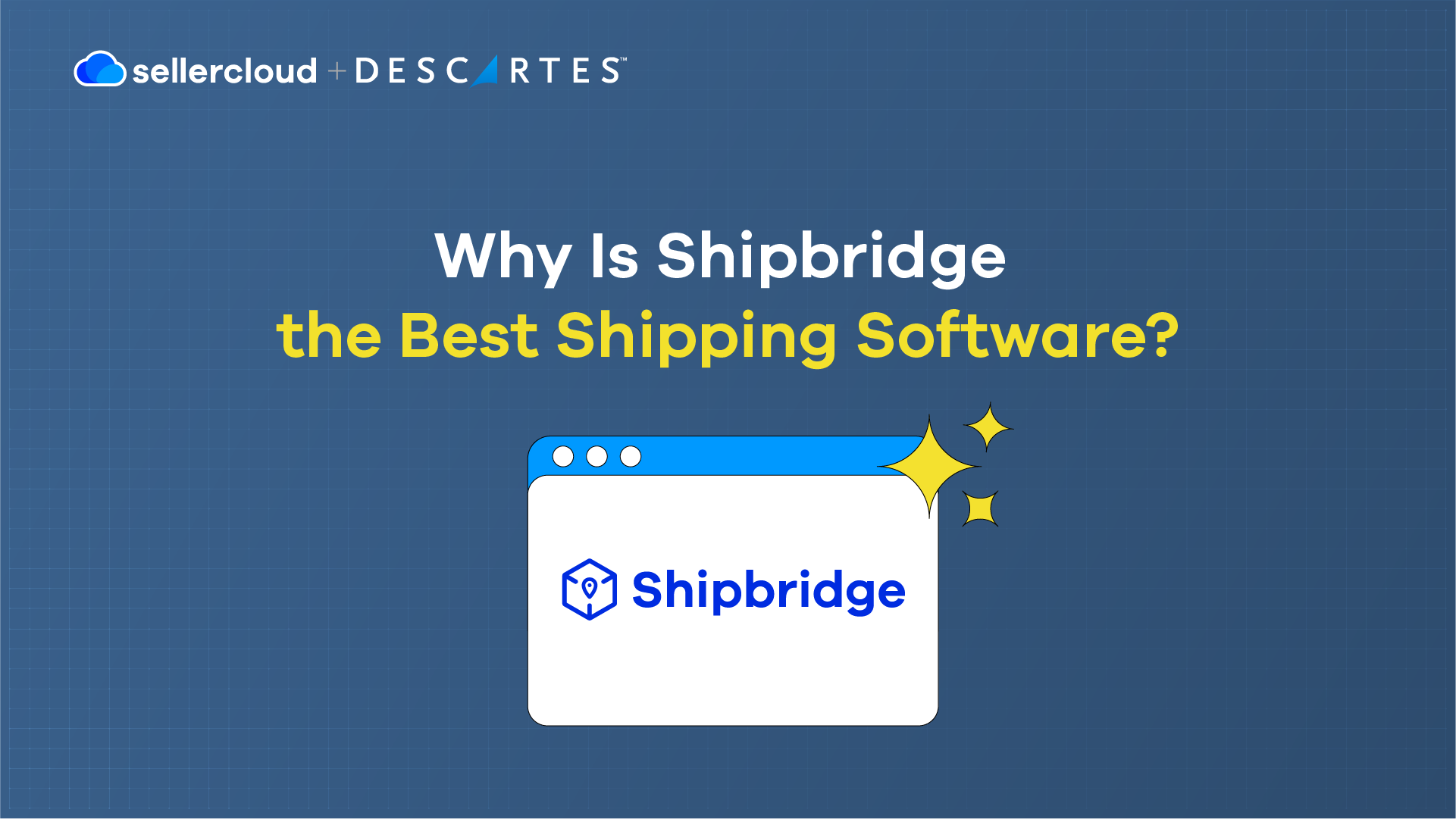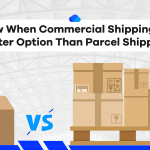
- Not all shipping software solutions are equal! Ideally, you want to have all the features you need at an affordable price that works for them.
- Sellercloud’s Shipbridge stands out as the best shipping solution for ecommerce because of its flexibility and affordability.
Where would ecommerce be without shipping? Shipping partners and software enable ecommerce companies to reach customers quickly and efficiently.
It’s a best practice to have as many shipping options as possible to always get the best price for what you need to ship.
Depending on the time of day, urgency, and distance, you may choose different shipping partners for your deliveries—that’s where shipping software makes a difference.
In this article, we’ll uncover the best shipping software solutions and discuss their pros and cons.
Top Ecommerce Shipping Software Solutions

1. Shipbridge (by Sellercloud)
Pros
- Allows sellers to shop rates with all the biggest shipping carriers in the US, such as FedEx and UPS, and international shipping options, such as DHL, Canada Post, and Royal Mail.
- Have set warehouses and stations and multiple users, which provides visibility into who shipped what and from where.
- Shipbridge can also be customized and automated with plugins and custom logic. Easily set up filters and create saved searches to find things you regularly look for when needed.
- Using Shipbridge’s ‘scan and ship’ helps ensure customers receive the products they ordered in the correct quantity.
- Shipbridge’s Sellercloud integration means that when you click on an order number, you can be taken directly to Sellercloud to view order details. (Shipbridge is free with a Sellercloud subscription.)
Cons
- Shipbridge is a desktop application and is not available as a web-based application.
- Shipbridge can only be used for sales orders and not for transferring inventory from one warehouse to another.
- Cannot generate credit memos to return inventory to vendors.
- Works only on Windows devices.
2. Descartes ShipRush
Pros
- Integrates with all major ecommerce platforms to manage orders and shipping.
- Descartes ShipRush offers discounted shipping rates with top carriers such as USPS, FedEx, UPS, and DHL.
- Saves time for high-volume sellers with bulk shipping tasks.
- Descartes ShipRush allows sellers to automate label creation and shipping rules for a smoother workflow.
- Responsive support team and resources for troubleshooting.
Cons
- May lack advanced options for highly customized shipping processes.
- Subscription pricing might not appeal to some, particularly low-volume sellers or those with inconsistent sales.
- Some users find Descartes ShipRush’s periodic interface changes disruptive to their experience.
- Doesn’t integrate with every niche or smaller ecommerce marketplace seamlessly.
3. ShipStation
Pros
- Operating for over a decade, ShipStation is one of the most well-known (and used) shipping software solutions for ecommerce sellers.
- ShipStation is URL-based, which means you can access it from any device with a browser. For some ecommerce businesses, this is better than having it locally installed.
- Integrates with most of the leading marketplaces and pulls in orders directly, making omnichannel order management easier.
- Can track inventory and allows barcode scanning. (However, inventory is not deducted when an order arrives but when the inventory is picked, making it an unreliable inventory management system for most omnichannel merchants.)
- ShipStation offers various automations to reduce manual work and human error.
Cons
- Some ecommerce businesses may dislike that ShipStation is URL-based and may prefer it locally installed so shippers can only use that specific program and nothing else.
- While affordable for smaller businesses, this is just one of the many solutions they need for their business to operate, and the costs soon pile up.
- Can be clunky and hard to learn to use. For some ecommerce sellers, it is not as intuitive as shipping directly through marketplaces like eBay or Etsy.
- Customer service can be hard to reach, and issues are not always resolved.
- ShipStation can feel like a trap for some ecommerce businesses who say it is hard to stop using their service because they will lose customer information.
4. ShipWorks
Pros
- ShipWorks automates tasks like label generation and notifications, saving time and minimizing errors for high-volume shipping operations.
- ‘ShipSense’ feature that learns shipping preferences, suggesting packaging and carriers to improve accuracy and efficiency for recurring orders.
- Has filters to sort and manage orders by criteria, such as weight, destination, and carrier. This helps ensure better workflow control.
- Allows multiple workstations, enabling teams to work collaboratively across locations and supporting simultaneous access to a single account.
- Allows barcode scanning, which speeds up order handling and inventory tracking and reduces manual errors.
Cons
- ShipWorks doesn’t come packaged with a broader ecosystem. You’ll have to invest in additional solutions to manage your ecommerce operations that might not integrate.
- Some customers have complained of glitches, saying that ShipWorks can sometimes stop working and that they must restart the whole program to keep working.
- ShipWorks requires a new license for every software or store you run, making it exceptionally expensive for multichannel sellers who must pay for each channel they sell on.
- ShipWorks customers have complained that it is not the most intuitive to use.
- Customers have also complained that comparing shipping rates in ShipWorks can be difficult.
5. ConnectShip (ToolKit)
Pros
- ConnectShip offers a good level of customization, allowing users to meet unique business shipping and logistics requirements.
- Integrates with a diverse range of carriers globally, which helps ecommerce businesses provide flexibility to their customers and optimize shipping costs.
- Caters to small businesses and large enterprises and can support growing companies as they expand.
- Compatible with select ERP, WMS (warehouse management system), and other ecommerce solutions, enabling shipping information to be easily shared with other tools and services.
- Good reporting tools to monitor and improve shipping performance and operational efficiency.
Cons
- Manual updates are required when there is a general rate increase and when updating fuel surcharges.
- Implementing ConnectShip can be a complex process. The initial setup can be intricate, time-consuming, and require dedicated IT resources.
- Licensing fees and ongoing maintenance can make ConnectShip an expensive shipping solution for small businesses.
- New ConnectShip users may need extensive training to leverage all functionalities effectively, prolonging the onboarding process.
- Some have criticized its unintuitive design, which could hinder ease of use for some users.
6. ShipWise
Pros
- A good option for scalability—can adapt to a growing business’s needs, supporting small startups to enterprise-level shipping operations.
- User-friendly interface helps simplify order management, tracking, and analytics. This makes ShipWise easier to learn to use and get shipping.
- As expected, ShipWise supports many carrier integrations, allowing businesses to choose the best option for each shipment.
- Provides detailed reporting and analytics to help companies to improve shipping performance and root out inefficiencies.
- Offers various pricing models that save on shipping costs for businesses of all sizes.
Cons
- Some customers have complained that ShipWise doesn’t explain all errors, making it difficult to solve them and prevent them from happening again.
- Setup and integration can be time-consuming, particularly when setting up shipping carriers. Integrating legacy systems may also require significant effort.
- Limited access to customer support can delay resolving urgent issues.
- Using some of ShipWise’s more advanced features can be a steep learning curve and require significant time and training.
- Initial setup and onboarding can be costly for smaller businesses.
Why Is Shipbridge the Best Shipping Software?

Designed for the modern ecommerce seller, Shipbridge reduces errors, speeds up fulfillment, and improves overall shipping accuracy.
Unlike many competitors, Shipbridge doesn’t charge based on the number of ecommerce channels you manage. This makes it especially appealing for businesses scaling across multiple platforms.
Shipbridge is also easy to set up, customizable, and backed by 24/7 customer support. It can efficiently handle even the most complex shipping needs, including international shipments.
When paired with a Sellercloud subscription, Shipbridge becomes even more valuable. It eliminates the need for multiple software solutions and gives you a clear, unified view of your entire order management process.
This integration also minimizes the risk of compatibility issues, a common challenge when mixing third-party ecommerce tools.
Sellercloud also has integrations with ShipStation, ShipWorks, and ConnectShip, which can be used alongside Shipbridge.
Additionally, the option to add custom plugins through Sellercloud ensures that Shipbridge can adapt to any business’s unique needs.
What Do Customers Say About Shipbridge?
Over the years, Shipbridge has garnered a loyal customer base.
In a case study, camping and hunting equipment seller Farwest Sports told us how Shipbridge blew their minds.
They called it “one of the best shipping programs out there” and found it refreshing that it integrates so well with Sellercloud and sends tracking information back to each of their channels.
In another case study, 3PL service ShipFlow told us they appreciate how easy Shipbridge is to use.
ShipFlow’s ease of use is a major advantage in the third and fourth quarters of the year when they’ll hire 20 or 30 temporary workers. “Shipbridge is really helpful when we have temps and we have new employees; they don’t need to know much,” he said.
Workers can quickly learn how to use Shipbridge and start working. Switching Shipbridge to Spanish also significantly simplifies their onboarding.
ShipFlow also praised how Shipbridge helped remove the need for employees to check and input information and only focus on getting orders out the door, which has helped them reduce errors.
Watch the video testimonial below to see how Shipbridge has helped many businesses already.
Book a Shipbridge demo today.
Key Points
Remember these key points.
- Shipping software is vital for ecommerce businesses to shop rates and get the best and most convenient shipping rates for their orders.
- A good shipping solution should offer diverse carrier integrations, feature an intuitive design, and be scalable, helping businesses grow from small to large.
- The top 5 best shipping software solutions are Shipbridge, Descartes ShipRush, ShipStation, ShipWorks, ConnectShip, and ShipWise.
- Shipbridge is the best shipping software because it streamlines operations, reduces costs, integrates seamlessly, and offers customization with 24/7 support.




